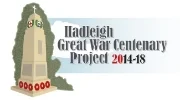Charles George Seager
Rank: Driver
Service Number: 64628
Date of Birth: 10 October 1887
Regiment: 76th Bty, Royal Field Artillery
Date of Death: 21 September 1916
Age at death: 28
Cemetery / Memorial: Basra Memorial
Country: Iraq
Grave / Reference: Panel 3 & 60
Relatives: Son of Robert and Rebecca Seager
Address: Benton Street, Hadleigh
The whereabouts of Charles' medals are currently unknown, but as he arrive in the Asia Minor theatre on 17 November 1915, he was entitled to the above three medals.
Driver Charles Seager
Charles George Seager was born on 10 October 1887 and was baptised in the Congregational Chapel. As a boy he probably attended the British School in the Market Place, what is now the Ansell Centre. In 1901 he was living at home on Benton Street with his parents Robert and Rebecca and his siblings, Mary, Christopher, Rose, Albert, Agnes, Violet and Nora.
By 1901 he was 13 years old and working in a cocao matting factory. In 1905 on his 18th birthday, Charles joined the Royal Navy. The next year, 1906, his father died. While in the Navy, Charles served on board ship with the channel fleet. However, he had a poor disciplinary record and in April 1909 was found guilty of being insubordinate and idle. He was given 28 days hard labour and dismissed from the Navy. By 1911 he had enlisted into the Army and was based at Woolwich with the Royal Field Artillery (RFA). Sometime later he was posted to India and serving with the 76th Battery, 10th Artillery Brigade of the 6th (Poona) Division of the Indian Army.
The advancing Ottomans caught up to the British in December 1915 and laid siege to the town. The British held out as long as possible and this in itself was at least keeping the Ottomans tied up, but running low on supplies the British eventually surrendered on 29 April 1916. The 13,000 British POWs were marched North, 400 miles across the desert to Aleppo in Syria.
By 1916 the Ottoman empire was racing to complete the Berlin to Bagdad railway line. This project was started many years before the war and was intended to strengthen the links between the German and the Ottoman empires. Large parts of the line had been completed, but difficult sections in the Taurus mountains in Southern Turkey and Northern Syria were still to be completed.
At the outbreak of war the Division were sent to Mesopotamia (modern day Iraq) with the objective of securing oil supplies. Towards the end of 1915 the British had advanced close to Baghdad, but unable to advance further and coming under pressure from the Ottoman forces, they started to retreat to the South. A decision was made to go halt the retreat and set up a defensive position in the town of Kut al-Amara. Kut lent itself to defence as it was surrounded by a large looping river.
Hadji Kiri Railway Station
By 1916 the Ottoman empire was racing to complete the Berlin to Bagdad railway line.
The urgency of the war made completing the line a priority for both the Germans and Turks. We know that thousands of allied POWs captured by the Ottomans were put to work on this railway. One such POW was another Hadleigh man, Harry Durrant who had been captured at Gallipoli in August of 1915. Records show that Harry died of dysentry while in captivity while a prisoner at Belemedik camp and was buried at Hadji Kiri cemetery on 17 September 1916. We know that the camps were rife with disease and thousands of men died as a result.
We have not found any records telling of how Charles died, only that he is listed as having died as a prisoner in Asia Minor on 29 Sep 16 (4 days after Harry Durrant’s death). While we cannot confirm that Charles actually made it to the prison camps in the Taurus mountains, it is possible that he did get there and suffered a similar fate to Harry.
Railway bridge constructed on the Berlin to Bagdad railway line near Hadki Kiri
Since Charles has no known grave, he is remembered on the Basra Memorial in Southern Iraq.
Two of Charles’ brothers, Albert and Christopher, both served with the 2nd Suffolks on the Western Front.

















